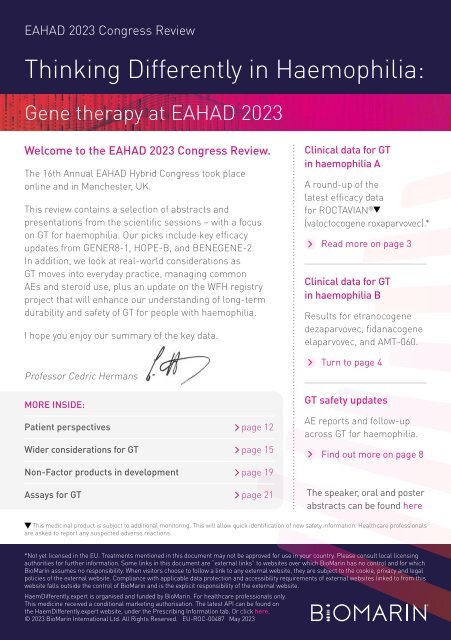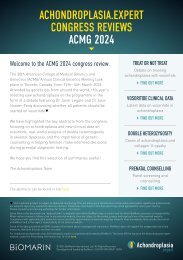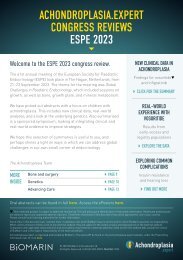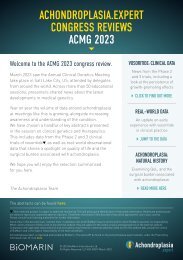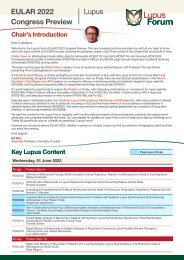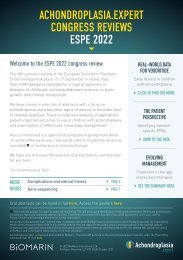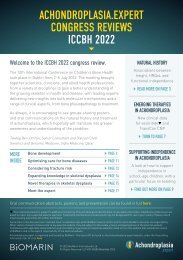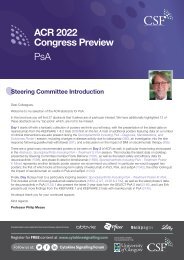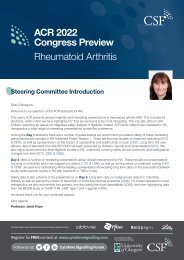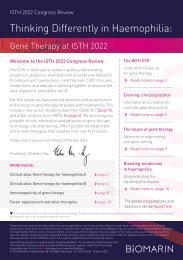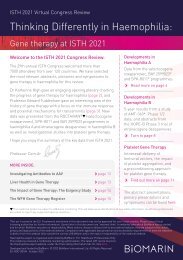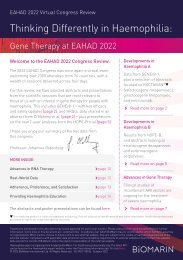EAHAD 2023 Congress Review
Create successful ePaper yourself
Turn your PDF publications into a flip-book with our unique Google optimized e-Paper software.
<strong>EAHAD</strong> <strong>2023</strong> <strong>Congress</strong> <strong>Review</strong><br />
Thinking Differently in Haemophilia:<br />
Gene therapy at <strong>EAHAD</strong> <strong>2023</strong><br />
Welcome to the <strong>EAHAD</strong> <strong>2023</strong> <strong>Congress</strong> <strong>Review</strong>.<br />
The 16th Annual <strong>EAHAD</strong> Hybrid <strong>Congress</strong> took place<br />
online and in Manchester, UK.<br />
This review contains a selection of abstracts and<br />
presentations from the scientific sessions – with a focus<br />
on GT for haemophilia. Our picks include key efficacy<br />
updates from GENER8-1, HOPE-B, and BENEGENE-2.<br />
In addition, we look at real-world considerations as<br />
GT moves into everyday practice, managing common<br />
AEs and steroid use, plus an update on the WFH registry<br />
project that will enhance our understanding of long-term<br />
durability and safety of GT for people with haemophilia.<br />
I hope you enjoy our summary of the key data.<br />
Professor Cedric Hermans<br />
MORE INSIDE:<br />
Patient perspectives page 12<br />
Wider considerations for GT page 15<br />
Non-Factor products in development page 19<br />
Assays for GT page 21<br />
Clinical data for GT<br />
in haemophilia A<br />
A round-up of the<br />
latest efficacy data<br />
for ROCTAVIAN ®<br />
(valoctocogene roxaparvovec).*<br />
Read more on page 3<br />
Clinical data for GT<br />
in haemophilia B<br />
Results for etranocogene<br />
dezaparvovec, fidanacogene<br />
elaparvovec, and AMT-060.<br />
Turn to page 4<br />
GT safety updates<br />
AE reports and follow-up<br />
across GT for haemophilia.<br />
Find out more on page 8<br />
The speaker, oral and poster<br />
abstracts can be found here<br />
This medicinal product is subject to additional monitoring. This will allow quick identification of new safety information. Healthcare professionals<br />
are asked to report any suspected adverse reactions.<br />
*Not yet licensed in the EU. Treatments mentioned in this document may not be approved for use in your country. Please consult local licensing<br />
authorities for further information. Some links in this document are “external links” to websites over which BioMarin has no control and for which<br />
BioMarin assumes no responsibility. When visitors choose to follow a link to any external website, they are subject to the cookie, privacy and legal<br />
policies of the external website. Compliance with applicable data protection and accessibility requirements of external websites linked to from this<br />
website falls outside the control of BioMarin and is the explicit responsibility of the external website.<br />
HaemDifferently.expert is organised and funded by BioMarin. For healthcare professionals only.<br />
This medicine received a conditional marketing authorisation. The latest API can be found on<br />
the HaemDifferently.expert website, under the Prescribing Information tab. Or click here.<br />
© <strong>2023</strong> BioMarin International Ltd. All Rights Reserved. EU-ROC-00487 May <strong>2023</strong><br />
1
<strong>EAHAD</strong> <strong>2023</strong> <strong>Congress</strong> <strong>Review</strong><br />
Current Status of GT in Haemophilia<br />
The treatment of haemophilia has evolved, driven by a need for better<br />
protection from bleeding. But have GT advances outpaced our fundamental<br />
knowledge of AAV gene transfer in humans?<br />
Radek Kazmarek from the Indiana University<br />
School of Medicine, US, gave a presentation<br />
on the current status of GT in haemophilia.<br />
Early GT studies reported low-level<br />
expression in muscle, and only short-lived<br />
expression in the liver – accompanied by<br />
transaminitis. The presenter stated that<br />
subsequent work has enabled a molecular<br />
revolution in the treatment of haemophilia,<br />
with AAV liver-targeted GT products now<br />
approved for use. However, Dr Kazmarek<br />
noted that some concerns remain about<br />
durability, predictability, and safety of GT<br />
for haemophilia. He went on to explain that<br />
at least 17 genes have been found to be<br />
associated with FVIII or VWF plasma levels,<br />
which could explain some of the variability<br />
observed. Suboptimal therapeutic responses<br />
cannot be adjusted, due to the universal<br />
development of anti-AAV antibodies, which<br />
precludes repeat GT dosing. At the other end<br />
of the spectrum, extremely high Factor levels<br />
after GT can result in treatment-induced<br />
haemophilic thrombosis. With regards<br />
immunotoxicity, some targets for mitigation<br />
have been suggested, these include IL-1,<br />
IL-6, the IL-6 receptor, type 1 IFN, and mTOR.<br />
In the future, there could also be a role for<br />
biochemical modulators to enhance rAAV<br />
transduction. Some unique challenges face<br />
GT for haemophilia A, including the fact that<br />
FVIII is primarily produced in LSECs, not<br />
hepatocytes, and that FVIII is a large and<br />
complex glycoprotein, which tends to misfold.<br />
Work on biobetter FVIII variants, engineered<br />
protein, or oversized AAV vectors may<br />
address some of these issues. Alternative<br />
gene transfer systems are also being<br />
investigated, such as lentiviral vectors or dual<br />
AAV/LNP gene editing. To help support robust<br />
scientific inquiry for the next generation of<br />
GT for haemophilia, a framework of known<br />
and unknown outcomes has been published.<br />
In his conclusion, Dr Kazmarek gave his<br />
opinion that AAV GT is still a work in progress,<br />
with plenty still to learn.<br />
Latest Clinical Data in GT for Haemophilia A<br />
Up-to-date results from a post hoc analysis of GENER8-1 – an ongoing<br />
Phase 3 trial of valoctocogene roxaparvovec in severe haemophilia A.<br />
A presentation by Doris Quon from the<br />
Orthopaedic HTC in Los Angeles, US,<br />
shared results from a post hoc analysis<br />
examining endogenous FVIII activity and<br />
procedure-related FVIII use and bleeding in<br />
the GENER8-1 trial. This looked at 134 male<br />
participants aged 18 or older and with<br />
FVIII ≤1 IU/dL on prophylaxis (ITT population)<br />
who received 6x10 13 vg/kg valoctocogene<br />
roxaparvovec. Endogenous FVIII activity<br />
was assessed throughout using CSA, and<br />
the closest measurement to a procedure<br />
or bleed was identified. Procedures were<br />
identified as non-invasive (e.g. tattoo, dental<br />
Mean FVIII activity and number of procedures performed<br />
Mean FVIII activity (IU/dL per CSA)<br />
150<br />
100<br />
50<br />
0<br />
n=67 n=33 n=11<br />
Minor<br />
without FVIII<br />
cleaning) or invasive (e.g. joint debridement,<br />
biopsies). FVIII prophylaxis could be used<br />
perioperatively, but major procedures were<br />
performed with FVIII treatment regardless<br />
of participant Factor level. Investigators<br />
were asked what had influenced their<br />
decision to perform procedures without FVIII.<br />
By the 2-year data cut, 260 procedures<br />
had been performed in 77 men. Dr Quon<br />
highlighted that of 111 invasive procedures,<br />
44 required FVIII treatment and 67 did not.<br />
Of the 44 performed with FVIII, 11 were<br />
major (joint debridement, arthrodesis) and<br />
33 were minor (dental extraction, biopsies).<br />
Minor invasive procedures performed without FVIII treatment were<br />
associated with higher participant FVIII activity per CSA<br />
Minor<br />
with FVIII<br />
Major<br />
with FVIII<br />
Number of procedures<br />
45<br />
40<br />
35<br />
30<br />
25<br />
20<br />
15<br />
10<br />
5<br />
0<br />
n=4<br />
n=6<br />
n=3<br />
<strong>EAHAD</strong> <strong>2023</strong> <strong>Congress</strong> <strong>Review</strong><br />
The 67 procedures performed without FVIII<br />
use were all minor. In the ITT population,<br />
mean FVIII activity at Weeks 52 and 104<br />
was 42.4 and 22.7 IU/dL, respectively. At the<br />
closest measurement to minor procedures,<br />
mean endogenous FVIII was 16.2 IU/dL for<br />
participants who required FVIII treatment,<br />
and 50.5 IU/dL for those who did not.<br />
The 6 participants who underwent major<br />
procedures all received FVIII infusions<br />
regardless of endogenous activity, and<br />
required more units than those undergoing<br />
minor procedures – 255.4 versus 67.2 IU/kg,<br />
respectively. Relatively few invasive<br />
procedure-related bleeds occurred,<br />
with just 18 episodes in 14 participants;<br />
13 episodes required FVIII treatment and<br />
5 did not; mean FVIII activity at the time was<br />
60.4 and 10.4 IU/dL for those not requiring<br />
and requiring treatment, respectively.<br />
The presenter noted that investigator<br />
questionnaire responses reflected the<br />
nature of personalised medicine with<br />
valoctocogene roxaparvovec, showing<br />
that most investigators had undertaken<br />
a case-by-case discussion about the use<br />
of FVIII treatment for procedures, given<br />
the participant’s endogenous activity<br />
achieved with GT and the type of procedure.<br />
The presentation concluded that FVIII use<br />
around minor procedures was associated<br />
with lower participant endogenous activity.<br />
Dr Quon closed by saying that the data from<br />
this study and the opinions reflected in the<br />
questionnaire suggest that valoctocogene<br />
roxaparvovec provides effective haemostatic<br />
control for up to 2 years, even with FVIII<br />
activity below WFH guidelines. [OR09]<br />
Latest Clinical Data in GT for Haemophilia B<br />
A selection of results for etranocogene dezaparvovec, fidanacogene<br />
elaparvovec, and AMT-060 in people with haemophilia B.<br />
Since GT for haemophilia is an innovative<br />
treatment approach, little is known about the<br />
management of surgery afterwards. An oral<br />
presentation from Niamh O’Connell from<br />
St James’s Hospital in Dublin, Ireland, looked<br />
at the management of dental procedures and<br />
surgeries in men who received etranacogene<br />
dezaparvovec in the Phase 2b (n=3) and<br />
Phase 3 (n=54) clinical trials. Information was<br />
collected about on-study dental procedures<br />
and surgeries, as well as exogenous FIX<br />
prophylaxis used to manage these events.<br />
At 2- and 3-years post-dosing, mean<br />
one-stage FIX activity levels were sustained<br />
at Over 2-year = 36.7 (n=50) Over 3-year =<br />
36.9 (n=3). The presenter reported that to<br />
date, 58% of participants have undergone<br />
a total of 18 dental procedures and 40<br />
surgeries; 45% were minor, and<br />
55% major. Joint surgeries comprised<br />
just over half of major surgeries (55%).<br />
No exogenous FIX prophylaxis was used<br />
for perioperative management of 72% dental<br />
procedures, including tooth extraction and<br />
implantation. Prophylaxis was also not used<br />
for perioperative management of 61% of<br />
minor and 9% of major surgeries. Either<br />
standard half-life or extended half-life<br />
FIX products were used in the remaining<br />
procedures; only a single FIX dose was used<br />
for 80% of dental procedures and 86% of<br />
minor surgeries. No safety concerns were<br />
raised, no inhibitors developed, and no<br />
thrombotic events were reported. In the<br />
abstract associated with this presentation,<br />
the authors concluded that etranacogene<br />
dezaparvovec achieved sustained FIX activity<br />
levels sufficient to undergo dental procedures<br />
and minor surgeries without exogenous FIX.<br />
The management of surgeries after GT was<br />
as expected, and comparable to people with<br />
mild haemophilia B, and there were no new<br />
safety concerns. [OR10]<br />
A poster from Pipe et al. looked at the<br />
durability of bleeding protection and FIX<br />
activity in people with and without AAV5 NAb<br />
in the Phase 3 HOPE-B trial, in which 54 adult<br />
males received etranacogene dezaparvovec<br />
at a dose of 2x10 13 gc/kg. AAV5 NAbs on<br />
day of dosing showed 33 were NAb-negative,<br />
and 21 were NAb-positive. The median<br />
AAV5 NAb titre in NAb-positive participants<br />
Summary of FIX activity* (%) by baseline AAV5 NAb status (Full analysis set)<br />
was 56.9, but 95% of NAb-positive participants<br />
had titres less than 1:700. One participant<br />
(titre 3212) did not express FIX Padua, and<br />
one (titre 198.9) received a partial dose; the<br />
other 52 participants were able to discontinue<br />
FIX prophylaxis. The poster showed that at<br />
18- and 24-months post-dose, no correlation<br />
was identified between baseline NAb titre<br />
and FIX level up to titre
<strong>EAHAD</strong> <strong>2023</strong> <strong>Congress</strong> <strong>Review</strong><br />
between infusion-related reactions and<br />
baseline NAb status (p=0.0956). The authors<br />
concluded that etranacogene dezaparvovec<br />
provided significant ABR reductions and<br />
an acceptable AE profile, regardless of<br />
NAb status, through 24-month follow-up.<br />
There was no association between baseline<br />
NAb status (titre
<strong>EAHAD</strong> <strong>2023</strong> <strong>Congress</strong> <strong>Review</strong><br />
13.3% resumed prophylaxis; 5 due to low<br />
FIX activity, and 1 due to bleed frequency.<br />
Mean FIX activity was 27.5 at Month 15,<br />
measured by OSA, and remained relatively<br />
stable at Month 24. Turning to look at the<br />
safety profile, Dr Kavakli noted that during the<br />
study, 84.4% of participants experienced ≥1 AE,<br />
and 62.2% received ≥1 dose of corticosteroid<br />
for elevated ALT, with mean time to initiation of<br />
GT: Safety<br />
45.3 days, and mean duration of 107.5 days.<br />
There was no thrombosis, malignancy, or<br />
inhibitor development. In summing up,<br />
Dr Kavakli concluded that treatment with<br />
fidanacogene elaparvovec met the primary<br />
endpoint, yielding endogenous FIX expression,<br />
resulting in significant decreases in bleeding<br />
and infusion rate, and with a generally well<br />
tolerated safety profile.<br />
Key safety questions for GT include transaminitis and corticosteroid use,<br />
and geno- or phenotoxicity. These presentations looked at key safety data<br />
from ongoing clinical trials, as well as some practical considerations.<br />
Wolfgang Miesbach gave a presentation on<br />
monitoring and dealing with AEs associated<br />
with GT. He began by stating that the most<br />
frequent AE seen with GT is ALT elevation, but<br />
there are also effects on immunosuppression,<br />
systemic infusion-related AEs, and the<br />
potential for highly elevated transgene<br />
and thrombosis. Possible risks debated<br />
include coagulopathy when additional Factor<br />
concentrates or emicizumab are given, or the<br />
development of inhibitors – although none<br />
have been reported to date. Other concerns<br />
include the risk of immune reactions to<br />
pre-existing AAV antibodies, and long-term<br />
malignancy and unexpected events. In clinical<br />
development, infusion-related AEs were<br />
documented in most trials, and were seen<br />
during therapy or up to 48 hours later.<br />
Phase 3 studies reported infusion-related<br />
AEs in 13% of haemophilia B subjects, and<br />
37% of haemophilia A. These AEs include<br />
mild events such as pyrexia, tachycardia,<br />
and hypotension, with only rare reports<br />
of severe hypotension and anaphylactic<br />
reactions. But there are effective strategies to<br />
deal with these, including slowing or pausing<br />
the initial infusion, providing supportive<br />
care, and extending the observation<br />
period. With regard to ALT elevations,<br />
Professor Miesbach noted that the first<br />
description of this AE in haemophilia GT<br />
was in 2006, when transient elevations were<br />
associated with a gradual decline in Factor<br />
expression, and a CD8+ T cell response<br />
against the AAV capsid. Subsequently it<br />
has been established that prednisolone is<br />
effective in limiting hepatocellular toxicity,<br />
as well as preserving transgene expression,<br />
especially when initiated early. Data from<br />
long-term 8-year follow-up show no recurrent<br />
episodes of elevated ALT, and no persistent<br />
or late-onset AEs. A dose-finding trial on<br />
the prophylactic use of immunosuppressives<br />
examined three different strategies in<br />
patients undergoing GT for haemophilia B.<br />
The results showed that different prophylactic<br />
regimens could not prevent ALT elevation,<br />
and were associated with late transaminitis<br />
when immunosuppression was tapered.<br />
It is possible that different management is<br />
needed for variable ALT patterns, taking into<br />
account timing of first elevation, and peak<br />
levels – which feasibly could have different<br />
underlying causes. Turning to rarer events,<br />
Professor Miesbach outlined the few cases<br />
of deep vein thrombosis and arteriovenous<br />
fistula thrombosis seen in haemophilia GT<br />
trials. He also noted there have been 4 cases<br />
of malignancy after GT for haemophilia,<br />
but histopathological findings suggest no<br />
evidence of integration of vector genomes,<br />
and concluded these cases are unrelated to<br />
GT. Long-term canine models suggest no<br />
altered liver function, no liver toxicity, and<br />
no evidence for tumorigenesis, but a small<br />
proportion of vectors do integrate, so there<br />
remains a potential risk. In neurological<br />
indications for AAV-based treatment safety<br />
alerts include toxicity in the spinal ganglia,<br />
muscular atrophy, and X-linked myotubular<br />
Summary of AEs in AAV-based GT<br />
lmmunogenicity<br />
Hepatotoxicity<br />
lmmunosuppression<br />
related AE<br />
Relevance for gene therapy of haemophilia<br />
• Pre-existing neutralising anti-AAV<br />
antibodies<br />
• Infusion-related reactions by innate<br />
immune response<br />
• T cell response against transduced cells<br />
ALT elevation:<br />
• transient<br />
• non-pathogenic<br />
• but related to transgene decrease<br />
• Dependent on the number, duration<br />
and effects of ALT elevation<br />
myopathy, but the mechanism for these<br />
is not well understood. Safety guidance<br />
recommends that HCPs promptly assess<br />
patients with worsening liver function tests<br />
or signs or symptoms of acute liver illness;<br />
if patients do not respond adequately to<br />
corticosteroids, consult a hepatologist and<br />
consider adjustment of the steroid regimen.<br />
A hub-and-spoke model has been proposed<br />
to manage GT in clinical practice, which<br />
encourages collaboration with hepatologists,<br />
psychologists, and physiotherapists. The<br />
model allows HTCs to become better qualified<br />
to deliver GT, to distribute responsibilities,<br />
and to make this treatment option accessible<br />
to all people with haemophilia. An important<br />
role for HTCs will be evaluation of factors such<br />
as liver health prior to GT, and to monitor<br />
and manage AEs post infusion. In conclusion,<br />
Professor Miesbach outlined that patient<br />
information, patient selection, and cooperation<br />
within the hub-and-spoke model will be key<br />
elements for patient safety, and this may<br />
evolve with more long-term data, including<br />
lifelong data collection in registries and<br />
safety surveillance systems.<br />
Relevance for other gene therapies<br />
• Complement activation and<br />
inflammation in non haemophilia trials<br />
leading to thrombotic microangiopathy<br />
• Progressive cholestatic hepatitis<br />
leading to acute liver failure<br />
• Dependent on the number, duration<br />
and effects of ALT elevation<br />
Professor Wolfgang Miesbach<br />
8 9
<strong>EAHAD</strong> <strong>2023</strong> <strong>Congress</strong> <strong>Review</strong><br />
Astermark et al. analysed elevated ALT in the<br />
HOPE-B trial – a principal safety outcome.<br />
The poster explained that ALT elevations were<br />
defined per protocol as ALT more than twice<br />
the subject’s baseline or greater than the<br />
laboratory upper limit of normal. Overall,<br />
12 ALT elevations were reported in 11 subjects;<br />
6 events were classed as mild, 5 as moderate,<br />
and 1 as severe. Baseline demographics in<br />
affected patients were comparable to those<br />
without ALT elevation. The poster highlighted<br />
that mean time to first elevation was 46.5 days,<br />
and mean elevated ALT duration was 38.2 days.<br />
Corticosteroids were given in 9 subjects per<br />
protocol, without reported serious AEs, and<br />
the mean corticosteroid use duration was<br />
79.8 days, at a mean dose of 27.2 mg/day. All<br />
subjects discontinued corticosteroids between<br />
Days 85–170 after GT. Mean FIX (% normal) in<br />
9 subjects treated with corticosteroids peaked<br />
at 22.2, prior to starting steroid treatment, and<br />
was 17.9 a fortnight afterwards. In comparison,<br />
mean FIX in those without increased ALT<br />
Effect of ALT elevations on FIX activity in HOPE-B<br />
Mean (±SD) peak FIX activity prior<br />
to corticosteroid treatment<br />
Mean (±SD) FIX activity prior to<br />
corticosteroid treatment<br />
Mean (±SD) FIX activity 2 weeks<br />
post-corticosteroid treatment<br />
Mean (±SD) FIX level post-etranacogene<br />
dezaparvovec administration<br />
Participants who received<br />
corticosteroids, n=9<br />
were 43.5, 46.0, 42.0, and 41.7 at 6, 12, 18,<br />
and 24-months post-treatment, respectively.<br />
Furthermore, mean ABR at Months 7–24<br />
was 0.8 and 1.1 in subjects with and without<br />
elevated ALT, respectively, and no subject<br />
returned to continuous prophylaxis. The<br />
authors concluded that these results suggest<br />
the supportive care and corticosteroid protocol<br />
used in HOPE-B achieved normalisation of<br />
liver transaminase levels and maintenance<br />
of most pre-steroid levels of FIX, without<br />
needing a return to prophylaxis. [PO040]<br />
Rasko et al. showcased the safety and<br />
efficacy of GT for haemophilia in HIV-positive<br />
participants. In the poster the authors note that<br />
people living with HIV represent an important<br />
subset within the haemophilia A community,<br />
but concerns about the interaction of AAV<br />
vectors with HIV medications – and associated<br />
hepatotoxicity – have led to their exclusion<br />
in many GT trials. This analysis evaluated<br />
SPK-8011 and SPK-8016 GT in 4 HIV-positive<br />
Participants with ALT<br />
elevations, n=11*<br />
Participants without<br />
ALT elevations, n=42<br />
22.2 (10.5) – –<br />
17.1 (8.1) – –<br />
17.9 (10.6) – –<br />
6 months 18.7 (11.1) 21.6 (11.8) 43.5 (17.6)<br />
12 months 16.7 (9.7) 20.3 (11.5) 46.0 (20.1)<br />
18 months 15.6 (7.9) 18.1 (9.1) 42.0 (21.2)<br />
24 months 15.5 (7.7) 18.4 (9.6) 41.7 (18.0)<br />
*One participant had an alcohol-related transaminase elevation that occurred on study day 740,<br />
and therefore was excluded from this analysis.<br />
Astermark et al [PO040]<br />
participants identified from two clinical trials<br />
and long-term follow-up studies. Individual<br />
safety and efficacy outcomes were assessed<br />
alongside concomitant HAART regimens.<br />
Each participant also had a history of<br />
treated HCV with a negative viral load.<br />
Only 1 serious AE was reported, which was<br />
considered unrelated to SPK-8011/8016.<br />
Overall, 8 treatment-related AEs were reported<br />
over median follow-up of 3.48 years; 7 were<br />
related to immunomodulatory therapy, and<br />
1 moderate ALT increase was related to GT.<br />
Of the 4 people with comorbid HIV, 75% had<br />
no indication of immune response to the<br />
vector, and did not receive immunomodulation,<br />
in comparison to 12.5% of the 24 participants<br />
without HIV. Prednisone was required in<br />
1 participant for a presumed capsid immune<br />
response; the authors noted that attempts<br />
to taper were confounded by intermittent<br />
elevated ALT and positive ELIspot tests<br />
for T-cell IFN-γ activity. To manage this,<br />
the HAART was optimised to facilitate the<br />
use of tacrolimus, but despite this trough<br />
levels were initially supratherapeutic due<br />
to a drug–drug interaction, requiring a<br />
further regimen change. Over 2.9–4.9 years,<br />
participants sustained FVIII expression levels<br />
of 15.1–28.0% as measured by OSA. Following<br />
infusion, ABR was reduced by 98.3–100% for<br />
all bleeds, and by 99.2–100% for spontaneous<br />
bleeds; AIR was reduced by 98.3–100%.<br />
The poster conclusions suggest these findings<br />
point to similar efficacy and safety profiles<br />
for SPK-8011 and SPK-8016 in HIV-positive<br />
participants compared to previous reports<br />
from the overall study populations. The data<br />
suggest carefully selected concomitant HAART<br />
is possible alongside liver-directed AAV GT,<br />
but the authors highlight that expertise in<br />
HIV management is essential and should be<br />
sought when immunomodulatory therapy is<br />
required. The final point on the poster states<br />
that these preliminary results encourage<br />
future AAV GT studies that do not exclude<br />
people living with HIV. [PO162]<br />
Rasko et al. also presented a poster on<br />
patterns of joint bleeds following GT with<br />
fidanacogene elaparvovec. Overall, 15 people<br />
with haemophilia B were treated at a dose<br />
of 5e11 vg/kg in a Phase 1/2a study for<br />
52 weeks, and 14 enrolled in long-term<br />
follow-up for up to 5 years. As of August 2022,<br />
8 patients were continuing, 4 completed, and<br />
2 discontinued, representing 3–6 years post<br />
infusion. The poster showed that FIX activity<br />
generally remained in the mild to normal<br />
range post infusion, and ABRs were low, with<br />
annual means
<strong>EAHAD</strong> <strong>2023</strong> <strong>Congress</strong> <strong>Review</strong><br />
GT: Real-World Data<br />
Real-world registries are an effective way to pool enough data to enable<br />
robust evaluation of rare safety events. GT registries will also collect<br />
information on durability.<br />
In an oral presentation, Donna Coffin<br />
from the WFH discussed building a global<br />
resource for the long-term follow-up of GT in<br />
haemophilia, and a collaboration between the<br />
WFH and national registries. The presenter<br />
outlined the core features of WFH GTR –<br />
a prospective, observational, and longitudinal<br />
registry based on a core data set that was<br />
developed by the GTR Steering Committee.<br />
Data will be collected either directly from<br />
participating HTC or through transfer from<br />
existing national registries via an integration<br />
programme. Participating HTCs will invite<br />
patients to enrol in the GTR once they have<br />
made the decision to receive GT, in a clinical<br />
trial or otherwise. Once informed consent is<br />
obtained, baseline and historic information<br />
will be obtained, and prospective data will<br />
be collected on an ongoing basis, at infusion<br />
and follow-up site. The GTR is already<br />
collaborating with national bodies in the<br />
USA, Germany, Netherlands, and Canada.<br />
Discussions on potential integrations with<br />
other national registries are ongoing. [OR07]<br />
process, infusion day, and follow-up.<br />
Along the journey, they have been identified<br />
as being key for psychosocial support, and<br />
actively participate to continuous education of<br />
patient conditions and treatment. Conversely,<br />
it has been highlighted that they may<br />
themselves require education about GT<br />
to help patients considering this option,<br />
and to support throughout the journey<br />
Patient journey for haemophilia including GT, and the role of the nurse<br />
1<br />
18 YEARS OF AGE<br />
Diagnosis<br />
2<br />
in a well-informed and safe manner.<br />
A multidisciplinary perspective, including<br />
nurse perspectives for mapping a patient<br />
journey for haemophilia, is key to improve<br />
quality of care, especially in case of paradigm<br />
shifts such as GT. The authors argues that this<br />
work places the nurse as one of key actors<br />
in management of people with haemophilia<br />
who may consider receiving GT. [PO305]<br />
Prophylactic Treatment<br />
• Realize on-demand/<br />
prophylactic infusions<br />
• Teach parents, how to infuse<br />
their child, and then the child<br />
to self-infuse<br />
• Ensure psychosocial support and<br />
motivate for adherence to treatment<br />
3<br />
Aware of Gene Therapy (GT)<br />
• Repeat neutral information<br />
about treatment opportunities<br />
including gene therapy to<br />
empower patient, including<br />
using the teach-back method<br />
Patient Perspectives<br />
Understanding patient perspectives and the individual’s GT journey is key to<br />
improve quality of care as this game-changing option moves into the mainstream.<br />
4<br />
Consider Gene Therapy<br />
5<br />
Eligibility Assessment<br />
• May coordinate eligibility<br />
testings<br />
• Communicate with other<br />
Haemophilia treatment<br />
centre members<br />
6<br />
Shared-decision Making Process<br />
• Checks if patient has all<br />
information needed to take<br />
a decision<br />
• First point of contact in case<br />
of questions/concerns<br />
• Provides information and<br />
psychosocial support<br />
LeQuellec et al. looked at the patient journey<br />
for people with haemophilia, with a focus<br />
on nurse perspectives and roles. The poster<br />
showed how a patient journey for haemophilia<br />
including GT was mapped, using a mixed<br />
system-approach including ethnographical<br />
interviews of patients, family members<br />
and HCPs – plus nurses with experience in<br />
haemophilia care with or without experience<br />
in GT clinical trials. Market research, literature<br />
screening, and peer-to-peer discussions<br />
were used to identify the critical steps, the<br />
people involved, and their respective roles<br />
in each step. Based on insights from 38 people<br />
interviewed and additional secondary sources,<br />
12 steps were identified from diagnosis to<br />
long-term follow-up post-administration of GT.<br />
These steps include 7 GT-specific items such<br />
as eligibility assessment, shared-decision<br />
making process, informed consent obtention<br />
as well as patient’s commitment to shortand<br />
long-term monitoring. As part of the<br />
multidisciplinary team, nurses were identified<br />
as playing a major role in two-thirds of<br />
steps, including but not limited to raising<br />
awareness about GT, shared decision-making<br />
7–8<br />
11<br />
Final Go & Inform Decision<br />
Short-term Monitoring<br />
• Track changes in QoL and<br />
need for care<br />
• Support patients in case of<br />
questions or concerns<br />
• Monitor the patient, manage<br />
bleeds or ALT elevations in the first<br />
months after GT administration<br />
9<br />
12<br />
Pre-infusion<br />
• Reassures patient that they<br />
made the right decision in<br />
case of doubts<br />
• Backs up or refers to gene<br />
therapy centre in case of questions<br />
Long-term Follow-up<br />
• Track changes in QoL and<br />
need for care<br />
• Support patients in case of<br />
questions or concerns<br />
• Monitor the patient, manage<br />
bleeds<br />
10<br />
Gene Therapy Infusion Day<br />
• First point of contact in case<br />
of questions or concerns<br />
during infusion day<br />
• Supports medical procedures<br />
and monitors patient closely for<br />
4 hours after GT<br />
Haemophilia<br />
nurse<br />
or<br />
Gene therapy<br />
nurse<br />
LeQuellec et al [PO305]<br />
12 13
<strong>EAHAD</strong> <strong>2023</strong> <strong>Congress</strong> <strong>Review</strong><br />
Woollacott et al. examined treatment<br />
preferences of people with haemophilia,<br />
showcasing the results from a discrete<br />
choice experiment in the UK. This study<br />
aimed to quantify patient preferences<br />
regarding treatment attributes when<br />
considering GT. 125 participants completed<br />
an online survey to collect demographic,<br />
clinical, and QoL information, before<br />
watching an educational video on GT<br />
principles. A discrete choice experiment was<br />
administered to elicit treatment preferences<br />
using five key attributes identified through<br />
prior qualitative research. Participants<br />
completed 14 hypothetical treatment<br />
scenarios (choice tasks) and relative weights<br />
were calculated. ‘Safety concerns’ for<br />
treatments were the most important attribute<br />
(33% importance), followed by ‘therapeutic<br />
option’ (how often treatment is provided;<br />
31%) and ‘role limitations’ (how haemophilia<br />
affects daily life; 24%). The least important<br />
attributes were ‘treatment effectiveness’ and<br />
‘hospital attendances and self-management’<br />
(9% and 3%, respectively). This study showed<br />
that people with haemophilia in the UK<br />
consider the safety of novel treatments<br />
including GT as highly important in<br />
decision-making. Furthermore, therapeutic<br />
option and impact on role limitations are<br />
valued more importantly than effectiveness.<br />
The poster conclusions highlight that<br />
this relationship should help inform<br />
health technology assessment decisions<br />
regarding the value patients place on<br />
specific attributes of GT. [PO338]<br />
In a session showcasing <strong>EAHAD</strong> research<br />
grant reports and awards, Ilaria Cutica<br />
from the University of Milan, Italy, gave<br />
an oral presentation on KAHaGeT –<br />
examining the knowledge and attitudes of<br />
people with haemophilia toward GT. Previous<br />
studies in the UK and the Netherlands have<br />
found a general lack of knowledge and<br />
education, but Professor Cutica believes<br />
this is the first study to investigate patient<br />
attitudes toward GT, their information<br />
needs, priorities and concerns, and how<br />
these factors might impact willingness to<br />
accept GT. In total 80 haemophilia patients<br />
at one HTC in Italy completed an online<br />
questionnaire to assess clinical data,<br />
GT knowledge, willingness to accept GT,<br />
and information needed for decision-making<br />
as well as priorities for safety, effectiveness,<br />
and QoL improvement, main concerns,<br />
and psychological characteristics such<br />
as risk-taking attitude. Overall, 87% of<br />
participants had haemophilia A, 80% were<br />
classed as severe, and a history of inhibitors<br />
was reported in 15%. The vast majority (93%)<br />
were satisfied with their current treatment.<br />
Professor Cutica showed that patients<br />
typically had poor knowledge of GT – with a<br />
few exceptions such as around general aims<br />
and functioning, and main positive effects.<br />
Two-thirds of people were able to answer<br />
fewer than half the questions correctly, and<br />
knowledge of detailed functioning, eligibility<br />
criteria, and the possible long- and<br />
short-term consequences was poor.<br />
Professor Cutica went on to demonstrate<br />
that the most appealing benefit of GT is<br />
not needing to perform infusions, followed<br />
by a reduction in bleeding, and having<br />
fewer restrictions in sports or travelling.<br />
Conversely, the most frequent concern that<br />
patients have is about potential long-term<br />
treatment consequences such as cancer,<br />
followed by short-term side-effects such as<br />
liver inflammation, and the possibility that GT<br />
will not be effective. In regard to willingness<br />
to undergo GT, 51% of participants would not<br />
accept it even when suggested by doctors;<br />
one of the factors that most influenced this<br />
preference was the possibility of losing<br />
effectiveness over time. Among the factors<br />
that most influenced the willingness to<br />
undergo GT were the possibility of fewer<br />
restrictions in sports and travelling and feeling<br />
safer in high-risk situations, and the prospect<br />
GT: Wider Considerations<br />
of reduction in bleeding and chronic joint<br />
pain. Importantly, having higher knowledge<br />
of GT increased the rate of acceptance.<br />
When asked for a minimum desired level of<br />
Factor that would make GT attractive, most<br />
patients said 25% for at least 15 years. These<br />
findings highlight how important effective<br />
educational plans are to enable people with<br />
haemophilia to fully understand GT and<br />
make an informed choice, but also show<br />
how durability and safety are key concepts<br />
that drive decision-making. [SP043]<br />
As part of the big picture for GT, it is important to look at considerations,<br />
including treatment expectations, specialties included in the HTC, and<br />
managing steroids.<br />
Brian O’Mahony – a patient working with<br />
the Irish Haemophilia Society – gave an oral<br />
presentation looking at what patients and<br />
payers should expect from GT. He began by<br />
noting that a key aspect for patients is setting<br />
and managing expectations, which should be<br />
based on realistic conversations with HCPs.<br />
This includes a person’s experience of living<br />
with haemophilia, their joint status, ABR, QoL,<br />
and activities and goals. Each patient should<br />
be given a clear understanding of knowns<br />
and unknowns, and be aware of long-term<br />
monitoring and follow-up requirements,<br />
including lifestyle implications in terms of<br />
alcohol and exercise. There should be solid<br />
arrangements to manage the journey,<br />
with clear coordination and roles in the<br />
hub-and-spoke, plus logistical arrangements<br />
to ensure the patient can comply with all<br />
monitoring requirements. Brian O’Mahony<br />
referred to a recent Canadian survey on<br />
haemophilia GT, which showed that 41% of<br />
respondents wanted to be sure of the Factor<br />
level they would achieve; this could represent<br />
a significant barrier to uptake when expression<br />
varies significantly. To address this, information<br />
and education is needed for individual<br />
comprehension levels across a multitude of<br />
platforms. The patient must be fully informed<br />
in a shared and objective decision-making<br />
process, and make an individual choice based<br />
on their personal needs and circumstances.<br />
Moving on to consider payers, Brian O’Mahony<br />
pointed out that important questions revolve<br />
around whether GT would pass a classic health<br />
technology assessment and cost-effectiveness<br />
threshold, and whether it is possible to<br />
extrapolate the potential durability of response.<br />
14 15
<strong>EAHAD</strong> <strong>2023</strong> <strong>Congress</strong> <strong>Review</strong><br />
Potential outcomes for payers<br />
Meaningful<br />
Accessible<br />
Timely<br />
Measurable<br />
Robust<br />
Predictable<br />
Clotting<br />
factor<br />
consumption<br />
Factor<br />
expression<br />
Annual<br />
bleeding<br />
rate<br />
(ABR)<br />
Currently, price indications suggest that<br />
one-time GT dosing is equivalent in cost to<br />
4–5 years’ prophylaxis with an EHL Factor<br />
product. The outcome of an ICER evaluation<br />
in the US suggested that value should not<br />
be determined exclusively by long-term cost<br />
offsets, since the current standard of care is<br />
priced excessively highly. There is a budget<br />
impact for a high one-off cost, but ultimately<br />
payers want GT to be affordable, with a cost<br />
no greater than current therapies. There<br />
remains concern about paying for uncertain<br />
outcomes, with questions around durability<br />
and expression, and the need for residual<br />
CFC which may be required. A solution to<br />
some of the challenges posed is alternate<br />
funding models, such as an annuity-based<br />
staged payment, coverage with evidence<br />
development, or outcomes-based rebates.<br />
Potential outcomes could be a decrease in<br />
use of Factor or emicizumab, with a resultant<br />
cost offset. Another possible outcome measure<br />
could be Factor expression level, with a defined<br />
threshold above which full payment will be<br />
made, and one for partial or no payment.<br />
These outcomes are easy to measure, will<br />
Annual joint<br />
bleeding<br />
rate<br />
(AJBR)<br />
Joint<br />
health<br />
(e.g. HJHS)<br />
/ ultrasound<br />
Generic<br />
QoL tools<br />
(e.g. EQ-5D,<br />
SF36)<br />
Disease<br />
specifc<br />
QoL tools<br />
(e.g. PROBE,<br />
Haemo-QoL)<br />
Brian O’Mahony<br />
be routinely monitored, and can be easily<br />
adjudicated in the event of a dispute. Other<br />
potential outcomes for a payment model such<br />
as ABR, HJHS, or HRQoL are more subjective,<br />
and difficult or intrusive to measure and<br />
monitor. Brian O’Mahony concluded that,<br />
ultimately, innovation in payment schemes and<br />
risk-sharing agreements will allow payers to<br />
manage budget whilst improving long-term<br />
outcomes and future-proofing advancements<br />
in care for people with haemophilia.<br />
Mark Gurnell from the University of<br />
Cambridge, UK, gave a presentation<br />
focused on dealing with steroid side effects<br />
and withdrawal. He outlined that there are<br />
consequences of excess glucocorticoid<br />
exposure, with multiple possible<br />
manifestations and complications, even<br />
with short-term use. This includes bone<br />
and ophthalmic AEs, and cardiometabolic<br />
complications such as dyslipidaemia, heart<br />
failure, or type 2 diabetes. The chance of<br />
these is significantly increased above a<br />
cumulative dose of 500 mg – a threshold<br />
that is quickly reached and exceeded at<br />
high daily dosages. This means regular<br />
monitoring is needed during steroid therapy,<br />
including the tapering and withdrawal period.<br />
Dr Gurnell pointed out that one key issue<br />
with prolonged steroid use is suppression<br />
of the hypothalamic-pituitary-adrenal axis,<br />
causing cortisol deficiency; this secondary<br />
deficiency can be hard to identify, and has<br />
many non-specific symptoms such as fatigue<br />
or generalised aches and pains. The amount<br />
of steroid that can be taken before this axis<br />
is permanently affected is very variable. With<br />
this is mind, there is clearly a need to safely<br />
withdraw oral corticosteroids, and be able to<br />
assess and manage adrenal insufficiency.<br />
Just 1 week of steroids at a dose of >40 mg/day<br />
is enough to switch the axis off, and requires<br />
tapering. Gradual withdrawal should also be<br />
considered in patients who have been given<br />
repeated doses in the evening, those who<br />
Monitoring in patients receiving oral corticosteroid<br />
Monitoring requirements<br />
Blood pressure*<br />
Bodyweight* †<br />
Body mass index*<br />
have been treated for more than 3 weeks<br />
or recently received repeated courses, as<br />
well people who have taken a short course<br />
within 1 year of stopping long-term therapy.<br />
Assessment of axis function commonly<br />
requires a cortisol test; this should be done<br />
first thing in the morning to account for<br />
diurnal variation, and with exogenous steroid<br />
withheld on the day of the test. If a patient has<br />
adrenal insufficiency they should be referred<br />
to endocrinology. In conclusion, Dr Gurnell<br />
noted that oral corticosteroid therapy may<br />
be associated with significant AEs, especially<br />
when used at high dosages, or for long-term<br />
therapy or repeated courses. As a general<br />
rule, aim for the lowest dose for the shortest<br />
possible period, and perform formal testing<br />
for adrenal insufficiency once steroids have<br />
been weaned to a physiologic dose equivalent<br />
and complete discontinuation is anticipated.<br />
Frequency<br />
Every appointment<br />
Regularly<br />
Regurarly<br />
Optometrist assessment for glaucoma and cataracts* Every 6–12 months §<br />
HbA1c or fasting glucose level* ‡<br />
Triglycerides and potassium*<br />
Adrenal suppression<br />
Osteoporosis risk<br />
Falls risk assessment<br />
Adverse effects<br />
(cardiovascular, endocrine/metabolic, GI, MSK,<br />
immunological, neurological, psychiatric, ophthalmic)<br />
Drug interactions<br />
Adapted from: NICE CKS Corticosteroids – Oral<br />
After 1 month then every 3 months<br />
After 1 month then every 6–12 months<br />
As indicated (especially during tapering to lower dosages)<br />
Periodically (and consider bone prophylaxis)<br />
Where appropriate<br />
Every appointment<br />
Every appointment and when medications changed<br />
*Ensure baseline measurements are taken before treatment; † Include height measurements for children<br />
and adolescents every 6 months and plot on growth chart; ‡ Monitor patients with diabetes more closely;<br />
§<br />
Arrange earlier in patients with cataracts.<br />
Professor Mark Gurnell<br />
16 17
<strong>EAHAD</strong> <strong>2023</strong> <strong>Congress</strong> <strong>Review</strong><br />
In an oral presentation, Vincenzo La Mura<br />
from the University of Milan, Italy, looked at<br />
why HTCs need a hepatologist. He noted that<br />
chronic hepatitis can be a multi-stage liver<br />
stage, and any hepatitis may evolve towards<br />
cirrhosis, with risks for portal hypertension,<br />
HCC, and organ failure. Critically, there<br />
is a high prevalence of viral hepatitis in<br />
people with haemophilia. In addition, HIV<br />
co-infection accelerates liver disease. This<br />
results in 20–30% of people with haemophilia<br />
developing end-stage liver disease,<br />
which can be difficult to transplant due to<br />
comorbidities. Dr La Mura emphasised that<br />
liver disease is the most common cause of<br />
death in people with haemophilia, but pointed<br />
out that there are successful vaccinations<br />
and anti-viral treatments, which makes<br />
collaboration between hepatologists and<br />
haematologists important. He suggested<br />
that this collaboration can be achieved either<br />
via a referral-based model or a screening<br />
programme with in-house follow-up –<br />
essentially where the hepatologist is on<br />
call versus included in the HTC as a staff<br />
member. Hepatological screening data from<br />
haemophilia patients at one centre in Milan<br />
show at least one potential risk factor in<br />
82% of people. The study also revealed signs<br />
suggestive of advanced fibrosis or cirrhosis<br />
in 16% of the HCV-exposed population, and<br />
several HCC cases. Dr La Mura argued<br />
that these findings support the need for<br />
hepatologists in HTCs: risk factors are<br />
frequent in people with haemophilia,<br />
and detecting and treating liver disease<br />
needs a specialist.<br />
Rasko et al. shared a poster examining<br />
the seroprevalence of NAb against AAV<br />
serotypes of relevance to GT in Europeans.<br />
The authors acknowledged that there are<br />
concerns that pre-existing NAb against AAV<br />
serotypes may interfere with GT. This subset<br />
analysis of a noninterventional, observational,<br />
retrospective, cross-sectional study focused<br />
on NAb prevalence against six AAV serotypes<br />
in 252 people from France, Germany, Italy,<br />
Spain, and the UK. Serum samples from<br />
the Pfizer Biobank were analysed from<br />
participants in previous non-GT clinical<br />
studies. NAb seroprevalence for the six<br />
AAV serotypes was estimated at a range of<br />
dilutions (from 1:1 to 1:50,000). At 1:1 dilution,<br />
NAb prevalence across countries ranged<br />
from 68.1–81.0% for AAV1; 53.2–71.4% for<br />
AAV5; 61.7–76.2% for AAV6; 57.4–69.0% for<br />
AAV8; 57.4–69.0% for AAV9; and 55.3–69.0%<br />
for AAVRh74var. Trends in NAb prevalence<br />
were similar in France, Germany, Italy, and<br />
the UK, but generally higher in Spain. At 1:4<br />
dilution, NAb prevalence was lowest for AAV5<br />
(Italy 19.1%, France 32.8%) and highest for<br />
AAV1 (Germany 52.0%, Spain 61.9%). Mean<br />
NAb titres (1/dilution) varied by country and<br />
were generally higher for AAV1 (Spain 110.2,<br />
France 212.6) and lower for AAV5 (Italy 5.3,<br />
France, 13.2). This analysis provides insight<br />
into the seroprevalence of NAbs against six<br />
different and clinically relevant AAV serotypes<br />
in adults across five European countries. The<br />
results shared in this poster suggest there is<br />
variation in seroprevalence geographically for<br />
a given AAV, as well as across different AAVs<br />
within a given country, which warrants further<br />
investigation on aetiology. [PO164]<br />
Non-Factor Product Updates<br />
Agents such as emicizumab and fitusiran have novel mechanisms of action, and<br />
may play an important role in restoring haemostasis in people with haemophilia.<br />
Pipe et al. investigated emicizumab prophylaxis<br />
for the treatment of infants with severe<br />
haemophilia A without FVIII inhibitors,<br />
based on an interim analysis of HAVEN 7 –<br />
a Phase 3b, open-label study in infants aged<br />
12 months or younger without FVIII inhibitors.<br />
Infants received emicizumab 3 mg/kg weekly<br />
for 4 weeks, then 3 mg/kg every 2 weeks<br />
for 52 weeks. Infants could stay on this dose<br />
or switch to 1.5 mg/kg weekly or 6 mg/kg<br />
every 4 weeks for the 7-year follow-up.<br />
At the data cut-off 54 infants received at least<br />
1 dose, with median treatment duration of<br />
42.1 weeks. Overall, 77 bleeds had occurred<br />
in 31 infants; of these 88.3% were traumatic,<br />
5.2% procedural, and 6.5% spontaneous.<br />
Overall, 14 treated bleeds – all traumatic –<br />
were reported in 12 infants, and none<br />
had more than 2 treated bleeds. Mean<br />
model-based ABRs for treated bleeds, all<br />
bleeds and treated joint bleeds were 0.4, 1.9,<br />
and 0.1, respectively. In total, 77.8% of infants<br />
had zero treated bleeds, while 42.6% had no<br />
bleeds at all. With regards safety, the poster<br />
showed that 92.6% of infants had at least 1 AE;<br />
16.7% of these were injection-site reactions.<br />
No AEs led to changes in or withdrawal<br />
from emicizumab. In total 12 serious AEs<br />
were reported in 8 infants, but none were<br />
considered to be related to emicizumab.<br />
No deaths, thrombotic events, or thrombotic<br />
microangiopathies have been reported. None<br />
of the 48 infants evaluable for immunogenicity<br />
tested positive for ADAs. Evaluable PK data in<br />
52 infants showed mean emicizumab trough<br />
concentrations increased during loading and<br />
were maintained, slightly above 60 μg/mL.<br />
The authors conclude that this interim analysis<br />
suggests that emicizumab is efficacious and<br />
well tolerated in infants with haemophilia A<br />
without FVIII inhibitors. [LCTR01]<br />
Kenet et al. shared results from a subgroup<br />
analysis of fitusiran efficacy and safety in<br />
adolescents with haemophilia, with or<br />
without inhibitors, from three Phase 3 trials –<br />
ATLAS-INH, ATLAS-A/B and ATLAS-PPX.<br />
As background they described how in<br />
ATLAS-INH and ATLAS-A/B, subjects with<br />
or without inhibitors, respectively, were<br />
randomised 2:1 to once-monthly 80 mg<br />
fitusiran prophylaxis or on-demand BPA<br />
(ATLAS-INH), or CFC (ATLASA/B) for 9 months.<br />
In ATLAS-PPX, subjects with or without<br />
inhibitors continued their prior CFC/BPA<br />
prophylaxis for 6 months before switching<br />
to monthly fitusiran prophylaxis for 7 months.<br />
Overall, 43 adolescents were analysed across<br />
the three studies. The results showed that<br />
median ABR was 1.7 (ATLAS-INH) and<br />
3.4 (ATLAS-A/B) in the fitusiran arm versus<br />
18.4 and 16.8 in the on-demand BPA and<br />
CFC arms, respectively. In ATLAS-PPX,<br />
median ABR was 0.0 in the fitusiran<br />
prophylaxis period versus 2.2 in the CFC/BPA<br />
prophylaxis period. Fitusiran improved HRQoL<br />
with a mean change in transformed total score<br />
from baseline to Month 9 of -18.2 and -10.8<br />
18 19
<strong>EAHAD</strong> <strong>2023</strong> <strong>Congress</strong> <strong>Review</strong><br />
versus -2.1 and 4.3 in the on-demand BPA<br />
and CFC arms of ATLAS-INH and ATLAS-A/B,<br />
respectively. In ATLAS-PPX, the mean change<br />
in transformed total score was -4.3 in the<br />
CFC/BPA prophylaxis period versus -6.3 in<br />
the full trial period. The poster stated that the<br />
safety profile of fitusiran in adolescents was<br />
consistent with that in adults, and showed<br />
that the most common treatment-emergent<br />
AEs in the fitusiran group in ATLAS-INH<br />
were URTI (36.5%), increased ALT (27.3%),<br />
increased blood alkaline phosphatase<br />
(27.3%); in ATLAS-A/B the most common<br />
were arthralgia (22.2%) and increased blood<br />
bilirubin (22.2%). There were no thrombotic<br />
events in ATLAS-A/B or -PPT; however,<br />
3 events were reported in 1 fitusiran participant<br />
in ATLAS-INH, but these were assessed as<br />
unlikely related to the study drug. The poster<br />
conclusions state that in adolescents with<br />
haemophilia A or B, with or without inhibitors,<br />
fitusiran prophylaxis demonstrated an<br />
improvement in bleeding phenotype across<br />
the three trials examined. By covering<br />
10 domains and having shown decreases<br />
in transformed total score, the Haemo-QoL<br />
supports broad improvements in HRQoL with<br />
fitusiran prophylaxis. In addition, the benefit–<br />
risk assessment was favourable, and supports<br />
further investigation into efficacy and safety in<br />
adolescents with haemophilia. [PO119]<br />
In a session on the latest clinical trial results,<br />
Robert Klamroth from the Vivantes Klinikum<br />
im Friedrichshain in Berlin, Germany,<br />
presented findings from an exploratory<br />
analysis to assess FVIII haemostatic<br />
equivalency of the revised fitusiran dose and<br />
regimen. As background, he drew attention to<br />
data from ATLAS-INH and ATLAS-A/B, which<br />
showed that fitusiran prophylaxis resulted<br />
in a sustained reduction in antithrombin,<br />
with constant lowering of around 90% from<br />
1 month onwards – but this did not reach the<br />
lower level of peak thrombin generation seen<br />
in healthy volunteers. A simulation based on<br />
PK/PD modelling identified a revised dose<br />
and regimen which targeted an antithrombin<br />
range of 15–35%. To better understand the<br />
haemostatic Factor equivalency of fitusiran<br />
prophylaxis, a QSP model was developed to<br />
investigate thrombin generation in people<br />
with haemophilia. This model was validated<br />
by comparing predicted simulated TGA traces<br />
with experimental spike-in data, based on the<br />
15–35% range. Professor Klamroth explained<br />
how peak thrombin levels observed at different<br />
steady-state antithrombin ranges in pooled<br />
Phase 1/2 fitusiran clinical studies were<br />
plotted. A population of 1,000 virtual people<br />
with severe haemophilia A was generated<br />
based on calibration of the QSP model to<br />
individual patient data from completed<br />
fitusiran clinical studies, which showed that<br />
peak thrombin at therapeutic antithrombin<br />
levels of 15–35% with fitusiran was similar<br />
to peak thrombin associated with 20–40%<br />
of FVIII in people with haemophilia A.<br />
Professor Klamroth concluded that fitusiran<br />
prophylaxis results in sustained lowering<br />
of antithrombin and increased thrombin<br />
generation in people with haemophilia with<br />
and without inhibitors, suggesting that fitusiran<br />
has the potential to rebalance haemostasis<br />
and provide continuous and sustained<br />
steady-state bleed protection. A revised<br />
fitusiran dose regimen targeting antithrombin<br />
levels at 15–35% is being evaluated in ongoing<br />
Phase 3 trials, with the aim of enhancing<br />
the benefit–risk profile of fitusiran.<br />
Assays<br />
Interpretation of FVIII activity levels when measuring GT-derived<br />
BDD-FVIII protein is complicated by the systematic discrepancies reported<br />
by the two common assays used to measure FVIII activity: OSA and CSA.<br />
Rojas et al. shared a poster on increased<br />
thrombin generation of GT-derived FVIII<br />
in patients administered SPK-8011<br />
(dirloctocogene samoparvovec). Previous<br />
results demonstrated that patients<br />
administered SPK-8011 have FVIII activity<br />
levels approximately 1.5-fold higher via OSA<br />
compared to CSA; however, it is yet to be<br />
determined if one assay is more reflective of the<br />
clinical benefit of GT-derived FVIII. To inform<br />
this issue, an investigation was undertaken to<br />
look at whether GT-derived FVIII demonstrated<br />
altered activity in TGA. As presented in the<br />
poster, analysis in patient plasma showed that<br />
SPK-8011-produced FVIII increased peak and<br />
total thrombin generation relative to FVIII in<br />
pooled normal plasma at comparable protein<br />
levels. The authors hypothesise that assays<br />
may show discrepant sensitivity to differences<br />
in FVIII specific activity, with those assessing<br />
global coagulation (OSA and TGA) more<br />
accurately capturing a potential enhancement<br />
in the downstream function of FVIII. Additional<br />
research to address this hypothesis is<br />
critical to inform the selection of assays<br />
for measuring GT-derived FVIII. [PO032]<br />
Obregón et al. shared a poster on the<br />
relationship between OSA and CSA<br />
discrepancies, and genetic analysis of<br />
the F8 gene in patients with non-severe<br />
haemophilia A. They noted that 30% of<br />
patients with mild haemophilia A show<br />
discrepancy in FVIII between OSA (FVIII:C1) and<br />
two-stage CSA (FVIII:CR). This observational,<br />
ambispective, and multicentre study<br />
determined FVIII:C1 and FVIII:CR in 52 patients<br />
from 9 Spanish hospitals. TGT was evaluated<br />
in platelet poor plasma, and mutation analysis<br />
performed by direct sequencing on individuals<br />
with discrepancy between the two assays.<br />
Results showed median FVIII:CR of 20.3%<br />
was higher than FVIII:C1 of 17.5% (p
<strong>EAHAD</strong> <strong>2023</strong> <strong>Congress</strong> <strong>Review</strong><br />
LIST OF ABBREVIATIONS<br />
AAV – adeno-associated virus<br />
ABR – annualised bleeding rate<br />
ADA – anti-drug antibody<br />
AE – adverse event<br />
AIR – annualised infusion rate<br />
ALT – alanine aminotransferase<br />
BDD – B-domain deleted<br />
BPA – bypassing agent<br />
CFC – clotting factor concentrate<br />
CI – confidence interval<br />
CSA – chromogenic assay<br />
<strong>EAHAD</strong> – European Association for Haemophilia<br />
and Allied Disorders<br />
EHL – extended half life<br />
EQ-5D-5L – EuroQol 5 dimensions health<br />
questionnaire<br />
FIX – Factor IX<br />
FVIII – Factor VIII<br />
gc – genome copies<br />
GT – gene therapy<br />
GTR – Gene Therapy Registry<br />
HAART – highly active antiretroviral therapy<br />
Haemo-QoL – haemophilia-specific quality of<br />
life questionnaire<br />
HbA1C – haemoglobin A1C<br />
Hem-A-QoL – Haemophilia Quality of Life<br />
Questionnaire for Adults<br />
HCC – hepatocellular carcinoma<br />
HCV – hepatitis C virus<br />
HCP – healthcare professional<br />
HJHS – haemophilia joint health score<br />
HRQoL – health-related quality of life<br />
HTC – haemophilia treatment centre<br />
IFN – interferon<br />
IL – interleukin<br />
ITT – intention to treat<br />
LNP – lipid nanoparticle<br />
LSEC – liver sinusoidal endothelial cell<br />
mTOR – mammalian target of rapamycin<br />
NAb – neutralising antibody<br />
OSA – one-stage clotting assay<br />
PD – pharmacodynamic<br />
PK – pharmacokinetic<br />
QoL – quality of life<br />
QSP – quantitative systems pharmacology<br />
SD – standard deviation<br />
TGA – thrombin generation assay<br />
TGT – thrombin generation test<br />
VAS – Visual Analog Scale<br />
vg – vector genomes<br />
VWF – von Willebrand factor<br />
WFH – World Federation of Hemophilia<br />
22


